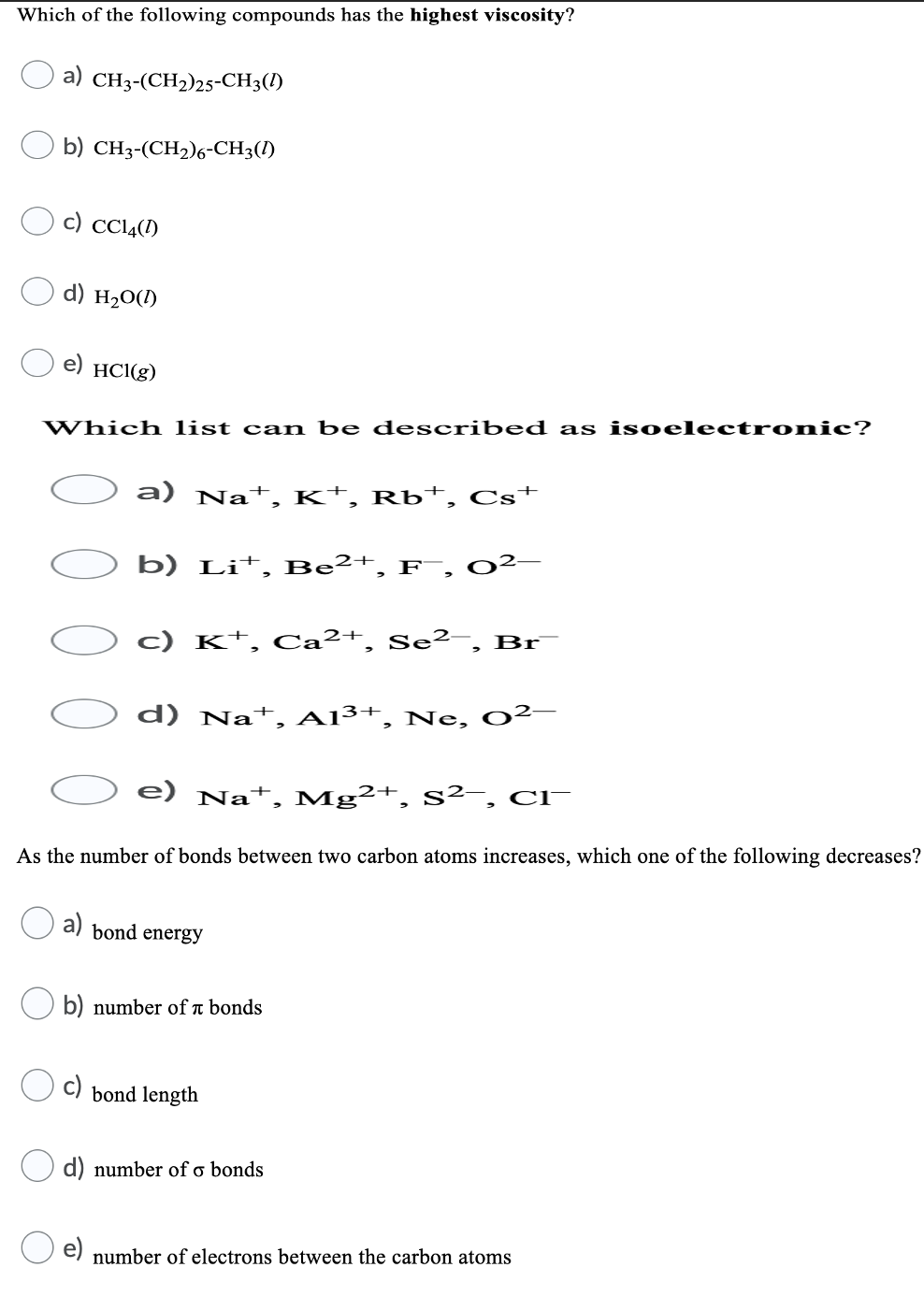Which of the following compounds has the highest viscosity? a) CH3-(CH2)25-CH3(1) b) CH3-(CH2)6-CH3(1) c) CC14(1) d) H20(!) e) HC1(g) Which list can be described as is oelectronic? a) Na+, K*, Rb†, Cs+ b) Li*, Be²+, F¯, c) K*, Ca²+, Se²-, Br d) Na+, A13+, Ne, o²- e) Na+, Mg²+, s²-, cI- As the number of bonds between two carbon atoms increases, which one of the following decrease a) bond energy b) number ofn bonds c) bond length d) number of o bonds number of electrons between the carbon atoms 00
Which of the following compounds has the highest viscosity? a) CH3-(CH2)25-CH3(1) b) CH3-(CH2)6-CH3(1) c) CC14(1) d) H20(!) e) HC1(g) Which list can be described as is oelectronic? a) Na+, K*, Rb†, Cs+ b) Li*, Be²+, F¯, c) K*, Ca²+, Se²-, Br d) Na+, A13+, Ne, o²- e) Na+, Mg²+, s²-, cI- As the number of bonds between two carbon atoms increases, which one of the following decrease a) bond energy b) number ofn bonds c) bond length d) number of o bonds number of electrons between the carbon atoms 00
Chemistry & Chemical Reactivity
9th Edition
ISBN:9781133949640
Author:John C. Kotz, Paul M. Treichel, John Townsend, David Treichel
Publisher:John C. Kotz, Paul M. Treichel, John Townsend, David Treichel
Chapter11: Intermolecular Forces And Liquids
Section11.4: Intermolecular Forces Involving Nonpolar Molecules
Problem 1RC
Related questions
Question
8

Transcribed Image Text:Which of the following compounds has the highest viscosity?
a) CH3-(CH2)25-CH3(I)
b) CH3-(CH2)6-CH3(I)
c) CC14(1)
d) H20(!)
e) HC1(g)
Which list can be described as isoelectronic?
a) Na+, K*, Rb*, Cs+
b) Li*, Be²+, F¯,
c) K*, Ca²+, Se²-, Br
d) Na+, A13+, Ne,
e) Na+, Mg²+, s²-, cI-
As the number of bonds between two carbon atoms increases, which one of the following decreases?
a) bond energy
b) number of a bonds
C) bond length
d) number of o bonds
e)
number of electrons between the carbon atoms
00
Expert Solution
This question has been solved!
Explore an expertly crafted, step-by-step solution for a thorough understanding of key concepts.
This is a popular solution!
Trending now
This is a popular solution!
Step by step
Solved in 2 steps

Knowledge Booster
Learn more about
Need a deep-dive on the concept behind this application? Look no further. Learn more about this topic, chemistry and related others by exploring similar questions and additional content below.Recommended textbooks for you

Chemistry & Chemical Reactivity
Chemistry
ISBN:
9781133949640
Author:
John C. Kotz, Paul M. Treichel, John Townsend, David Treichel
Publisher:
Cengage Learning

Chemistry
Chemistry
ISBN:
9781305957404
Author:
Steven S. Zumdahl, Susan A. Zumdahl, Donald J. DeCoste
Publisher:
Cengage Learning


Chemistry & Chemical Reactivity
Chemistry
ISBN:
9781133949640
Author:
John C. Kotz, Paul M. Treichel, John Townsend, David Treichel
Publisher:
Cengage Learning

Chemistry
Chemistry
ISBN:
9781305957404
Author:
Steven S. Zumdahl, Susan A. Zumdahl, Donald J. DeCoste
Publisher:
Cengage Learning


Chemistry: An Atoms First Approach
Chemistry
ISBN:
9781305079243
Author:
Steven S. Zumdahl, Susan A. Zumdahl
Publisher:
Cengage Learning

Chemistry & Chemical Reactivity
Chemistry
ISBN:
9781337399074
Author:
John C. Kotz, Paul M. Treichel, John Townsend, David Treichel
Publisher:
Cengage Learning

Chemistry: Principles and Practice
Chemistry
ISBN:
9780534420123
Author:
Daniel L. Reger, Scott R. Goode, David W. Ball, Edward Mercer
Publisher:
Cengage Learning